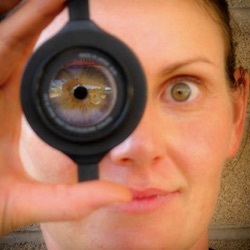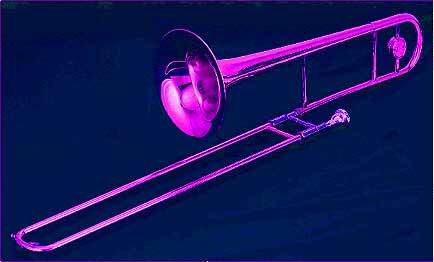Marc Abrahams's Blog, page 120
April 17, 2020
Stingless Bees’ Zippy Landing Benefits Traffic Congestion
 Ig Nobel Prize-winning scientists who discovered that dung beetles use the Milky Way to navigate have now learned (together with some colleagues) how certain bees probably manage to tamp down traffic congestion. Their study is:
Ig Nobel Prize-winning scientists who discovered that dung beetles use the Milky Way to navigate have now learned (together with some colleagues) how certain bees probably manage to tamp down traffic congestion. Their study is:
“Accelerated Landing in a Stingless Bee and Its Unexpected Benefits for Traffic Congestion,” Pierre Tichit, Isabel Alves-dos-Santos, Marie Dacke and Emily Baird [pictured here], Proceedings of the Royal Academy B: Biological Sciences, epub 2020. (Thanks to Tony Tweedale for bringing this to our attention.) The authors report:
“we recorded the stingless bees Scaptotrigona depilis landing on their natural hive entrance—a narrow wax tube built by the bees themselves. Rather than decelerating before touchdown as most animals do, S. depilis accelerates in preparation for its high precision landings on the narrow tube of wax. A simulation of traffic at the hive suggests that this counterintuitive landing strategy could confer a collective advantage to the colony by minimizing the risk of mid-air collisions and thus of traffic congestion. If the simulated size of the hive entrance increases and if traffic intensity decreases relative to the measured real-world values, ‘accelerated landing’ ceases to provide a clear benefit, suggesting that it is only a useful strategy when target cross-section is small and landing traffic is high.”
The 2013 Ig Nobel Prize for biology & astronomy was awarded to Marie Dacke, Emily Baird, Marcus Byrne, Clarke Scholtz, and Eric J. Warrant, for discovering that when dung beetles get lost, they can navigate their way home by looking at the Milky Way.
The describe that work in the study “Dung Beetles Use the Milky Way for Orientation,” Marie Dacke, Emily Baird, Marcus Byrne, Clarke H. Scholtz, Eric J. Warrant, Current Biology, epub January 24, 2013.
Shows in Stockholm
Emily Baird was scheduled to appear in two Ig Nobel shows in Stockholm, on Monday and Tuesday, April 20 and 21. You might have been able to enjoy coming to either of those shows, and asking about the bee landing discovery, as well as the dung beetles, had those shows not been postponed because of the COVID-19 pandemic.

April 15, 2020
Podcast Episode #208: “Repetitive Physics of ‘OM'”
Repetitive Physics of ‘OM’; Clever Contraptions to Capture Criminals; the Watch on the Loo; Glug-Glug of Ideal Bottles; Boys Will Be Boys; What Women Find More Disgusting than Men; Pseudostupidity; a Cat, a Cow, and a Bag; The Burgler and the Cheesy Toothmark; Chickens Prefer Beautiful People.
In episode #208, Marc Abrahams shows some unfamiliar research studies to Jean Berko Gleason, Andrew Berry, Chris Cotsapas, Corky White, and Maggie Lettvin. Dramatic readings and reactions ensue.
Remember, our Patreon donors, on most levels, get access to each podcast episode before it is made public.
1. Jean Berko Gleason encounters:
Gurjar, Ajay Anil, and Siddharth A. Ladhake (2008). ‘Time-Frequency Analysis of Chanting Sanskrit Divine Sound “OM”.’ International Journal of Computer Science and Network Security 8 (8): 170–75. (2009).
‘Spectral Analysis of Sanskrit Divine Sound OM.’ Information Technology Journal 8: 781–85. (2009).
‘Optimal Wavelet Selection For Analyzing Sanskrit Divine Sound “OM”.’ International Journal of Mathematical Sciences and Engineering Applications 3 (2): 225–33. (2009).
‘Analysis of Speech Under Stress Before and After OM Chant Using MATLAB 7.’ International Journal of Emerging Technologies and Applications in Engineering, Technology and Sciences 2 (2): 713–18. (2009).
‘Time-Domain Analysis of “OM” Mantra to Study It’s [sic] Effect on Nervous System.’ International Journal of Engineering Research and Industrial Applications 2 (3): 233–42.
Gurjar, Ajay Anil (2009). ‘Multi-Resolution Analysis of Divine Sound “OM” Using Discrete Wavelet Transform.’ International Journal of Emerging Technologies and Applications in Engineering, Technology and Sciences 2 (2): 468–72.
2. Andrew Berry encounters:
Oscar V. Hargrave’s “Means of Defense” (U.S. patent 1381301, granted 1921)
Samuel D. Goswick’s “Robber Exterminator” (U.S. patent 1500188, granted 1924)
Ernest English’s “Burglar Trap” (U.S. patent 1607066, granted 1926)
3. Jean Berko Gleason encounters:
Watson, T. Steuart (1996). ‘A Prompt Plus Delayed Contingency Procedure for Reducing Bathroom Graffiti.’ Journal of Applied Behavior Analysis 29 (1): 121–24.
4. Chris Cotsapas encounters:
Clanet, Christophe, and Geoffrey Searby (2004). ‘On the Glug-Glug of Ideal Bottles.’ Journal of Fluid Mechanics 510: 145–68.
“Container having no-glug pouring spout.” U.S. Patent 5346106, issued to Carl D. Ring, September 13, 1994.
“Anti-glug vent for plastic pails.” U.S. Patent 5906288, issued to Davis B. Dwinell, May 25, 1999
“Low cost spill-and-glug-resistant cup and container.” U.S. Patent 7757886, issued to I.-C. Ho, July 20, 2010.
“A continuous swallowing movement measuring device and method for measuring a continuous swallowing movement,” Canadian patent CA2575958, issued May 17, 2011, to Hidetoshi Kojima, Hirotaka Kaneda, and Toyohiko Hayashi.
5. Corky White encounters:
“And Now, a Needle in the Rectum,” Naresh K. Soni, Ashwini Gupta, and Narayan S. Shekhawat, Indian Journal of Gastroenterology, vol. 16, no. 2, April 1997, pp. 77–8.
“Testosterone Concentration in the Seminal Plasma of Cocks,” M. Zeman, J. Kosutzky, and Eugenia Bobakova, British Poultry Science, vol. 27, 1986, pp. 261–6.
“The Nubility Hypothesis,” Frank Marlowe, Human Nature, vol. 9, no. 3, 1998, pp. 263–71.
6. Chris Cotsapas encounters:
“Disgust Sensitivity and the Sex Difference in Fears to Common Indigenous Animals,” W.A. Arrindell, S. Mulkens, J. Kok, and J. Vollenbroek, Behaviour Research and Therapy, vol. 37, no. 3, March 1999, pp. 273-80.
7. Jean Berko Gleason encounters:
“Pseudostupidity and Analyzability,” L.S. Cohn, Journal of the American Psychoanalitic Association, vol. 37, no. 1, 1989, pp. 131-45.
“Pseudostupidity: a Study in Masochistic Exhibitionism,” W.N. Evans, Psychoanalitic Review, vol. 61, no. 4, Winter 1974-75, pp. 619-32.
8. Maggie Lettvin encounters:
Ely, Fordyce, and W. E. Petersen (1941). ‘Factors Involved in the Ejection of Milk.’ Journal of Dairy Science 3: 211–23.
May, D. N. (1971). ‘Startle in the Presence of Background Noise.’ Journal of Sound and Vibration 17 (1): 77–78.
Lukas, Jerome. S. (1972). ‘Awakening Effects of Simulated Sonic Booms and Aircraft Noise on
Men and Women.’ Journal of Sound and Vibration 20 (4): 457–66.
Rylander, R., S. Sörensen, and K. Berglund (1972). ’Sonic Boom Effects on Sleep: A Field Experiment on Military and Civilian Populations.’ Journal of Sound and Vibration 24 (1): 41–50.
9. Corky White encounters:
“Saliva from Cheese Bite Yields DNA Profile of Burglar: A Case Report,” D. Sweet and D. Hildebrand, International Journal of Legal Medicine, vol. 112, no. 3, 1999, pp. 201–3.
10. Jean Berko Gleason encounters:
“Chickens Prefer Beautiful Humans.” Stefano Ghirlanda, Liselotte Jansson, and Magnus Enquist, Human Nature, vol. 13, no. 3, 2002, pp. 383-9.
“Do Mynahs prefer peacock feathers of more regular pattern?” Tomomichi Kobayashi, Ornis Svecica 9, 1999, 59–64.
Bruce Petschek, Audio Engineer
John Shedler, Audio Engineer
Seth Gliksman, Production Assistant
Available on Spotify, Apple Podcasts, Overcast, Google Podcasts, AntennaPod, BeyondPod and elsewhere!

April 13, 2020
The ‘Stroop Effect’ as Applied to Trombonists [new study]
A new variant of the psychologists’ stock-in-trade ‘Stroop test’ has been discovered – applicable only to trombonists.
Background:
 The ‘Stroop Effect’ (a cognitive interference where a delay in the reaction time of a task occurs due to a mismatch in stimuli) is named after John Ridley Stroop who wrote the first academic paper (in English*) about it in 1935. Since then, a plethora of experiments have confirmed the effect in various ways. Now, in 2020, a new variant has been discovered and described.: Named as ‘The Trombone Congruency Effect.’. It was revealed in a set of experiments performed at the University of Connecticut, US, which compared musically related response times of trombonists and non-trombonists (along with non-musicians as a control).
The ‘Stroop Effect’ (a cognitive interference where a delay in the reaction time of a task occurs due to a mismatch in stimuli) is named after John Ridley Stroop who wrote the first academic paper (in English*) about it in 1935. Since then, a plethora of experiments have confirmed the effect in various ways. Now, in 2020, a new variant has been discovered and described.: Named as ‘The Trombone Congruency Effect.’. It was revealed in a set of experiments performed at the University of Connecticut, US, which compared musically related response times of trombonists and non-trombonists (along with non-musicians as a control).
See: ‘Movement is part of the meaning of music notation: A musical Stroop effect for trombonists’, Topher Logan, Roger Chaffin, Psychology of Music, Feb. 2020
*Note : It had already been described (in German) some years earlier : Jaensch, E.R (1929). Grundformen menschlichen Seins. Berlin: Otto Elsner und Mitarbeiter.
Researchreseach Martin Gardiner

April 12, 2020
Pocket-Sized #1001: “Cocker’s Arithmetick”
Cocker’s Arithmetick
In this Pocket-Sized episode #1001, Marc Abrahams shows just a wee bit of an unfamiliar research study to Mason Porter. Dramatic readings and reactions ensue.
The research mentioned in this episode is featured in the Mathematics Special Issue (Vol. 16, #4) of the Annals of Improbable Research Magazine.

Remember, our Patreon donors, on most levels, get access to each podcast episode before it is made public.
1. Mason Porter encounters:
Cocker’s Arithmetick: Being a Plain and Familiar Method Suitable to the Meanest Capacity for the Full Understanding of That Incomparable Art, As It Is Now Taught by the Ablest School-Masters in City and Country, Edward Cocker, 1677, John Hawkins [publisher], London.
Seth Gliksman, Production Assistant
Available on Spotify, Apple Podcasts, Overcast, Google Podcasts, AntennaPod, BeyondPod and elsewhere!

April 11, 2020
Pass the salt (A Rube Goldbergian machine)
The video above is styled after the roundabout-action machines designed, a few generations ago, by cartoonist Rube Goldberg. This one was designed by Joseph’s Machines. (Thanks to Bob Rosa for bringing the video to our attention.)
Meanwhile, Rube Goldberg’s granddaughter is overseeing a contest to build a supremely inefficient hand-washing machine. Hilarie M. Sheets of The New York Times did a nice writeup of the contest and the history of Rube Goldberg machines.
Modern discussions of Rube Goldberg machines should not neglect to mention what are the (probably) most elegant members of the genre, the machines designed by Arthur Ganson.

April 10, 2020
The special Big Animals issue—Improbable Research
The special Big Animals issue (vol. 26, no. 2) of the magazine tramples forth with reports about improbable research about animals that are big. And improbable. And real.

Perhaps this is the psychologically right moment to subscribe, or to buy one of the more than 150 back issues that explore all sorts of improbable things.

A look back at some high-flying crime fighters
The 1994 Ig Nobel Peace Prize was awarded to John Hagelin of Maharishi University and The Institute of Science, Technology and Public Policy, promulgator of peaceful thoughts, for his experimental conclusion that 4,000 trained meditators caused an 18 percent decrease in violent crime in Washington, D.C.
Hagelin tried to get himself elected President of the United States, running as a member of the Natural Law Party.
The Natural Law party tried to attain high political office in several countries. This video was part its campaign in the UK. (Thanks to Richard Fisher for bringing the video to our attention.

April 8, 2020
Research Study Announces: “Where There Are Girls, There Are Cats”
The specific question of whether cats are where girls are is addressed in a new study:
“Where There Are Girls, There Are Cats,” Yuhang Li, Yue Wan, Yigui Zhang, Zhaomei Gong, and Zhongqiu Li, Biological Conservation, epub 2020. (Thanks to Tom Gill for bringing this to our attention.) Here are details from the study:
The authors, at Nanjing University, China, explain:
“In this study, we provided robust estimates of free-ranging cat density in 30 universities in Nanjing, Jiangsu Province, China. We found that the population density of free-ranging cats is linearly related to the proportion of female students in the university. An online questionnaire confirmed that human females were more concerned about the living conditions of free-ranging cats than human males in China. By contrast, a socialization test on 27 free-ranging cats suggests that the cats may have the ability to distinguish human sex and adopt a sociable skill to human females.”
But then…
The journal’s publisher published the article online, then removed it, replacing it with this terse notice:
“The publisher regrets that this article has been temporarily removed. A replacement will appear as soon as possible in which the reason for the removal of the article will be specified, or the article will be reinstated. The full Elsevier Policy on Article Withdrawal can be found at https://www.elsevier.com/about/our-business/policies/article-withdrawal.”
Retraction Watch had a few things to say about this.

April 6, 2020
Deep Learning to Help People Know Your Shit
A new, distinct form of backend processing— a very distant relative of potty training, for computers—is presented in this new study:
“A mountable toilet system for personalized health monitoring via the analysis of excreta,” Seung-min Park, Daeyoun D. Won, Brian J. Lee, Diego Escobedo, Andre Esteva, Amin Aalipour, T. Jessie Ge, Jung Ha Kim, Susie Suh, Elliot H. Choi, Alexander X. Lozano, Chengyang Yao, Sunil Bodapati, Friso B. Achterberg, Jeesu Kim, Hwan Park, Youngjae Choi, Woo Jin Kim, Jung Ho Yu, Alexander M. Bhatt, Jong Kyun Lee, Ryan Spitler, Shan X. Wang, and Sanjiv S. Gambhir, Nature Biomedical Engineering, 2020. (Thanks to Abhishek Nagaraj for bringing this to our attention.)
The authors, at institutions in the USA, South Korea, Canada, and The Netherlands, explain:
Here, we describe easily deployable hardware and software for the long-term analysis of a user’s excreta through data collection and models of human health. The ‘smart’ toilet, which is self-contained and operates autonomously by leveraging pressure and motion sensors, analyses the user’s urine using a standard-of-care colorimetric assay that traces red–green–blue values from images of urinalysis strips, calculates the flow rate and volume of urine using computer vision as a uroflowmeter, and classifies stool according to the Bristol stool form scale using deep learning, with performance that is comparable to the performance of trained medical personnel. Each user of the toilet is identified through their fingerprint and the distinctive features of their anoderm, and the data are securely stored and analysed in an encrypted cloud server.

Recent progress in ‘IKEA catalogue’ studies
The cultural, artistic and linguistic implications (and more) of the IKEA catalogue have not been overlooked by academia. Here is a (non-exhaustive) list of some relevant publications over the last 10 years or so.
• Neoliberalism in your living room: A spatial cognitive reading of home design in IKEA catalogue
• Presupposition based on IKEA catalogue 2017 edition [.pdf ]
• Silent IKEA: The Negativity and Politics of Retail Image in the IKEA catalogue
• The IKEA Catalogue: Design fiction in academic and industrial collaborations [.pdf ]
And the latest (May 2020) :
• T/V pronouns in global communication practices: The case of IKEA catalogues across linguacultures
The photo is featured in : The IKEA Catalogue: Design fiction in academic and industrial collaborations.
Research research by Martin Gardiner

Marc Abrahams's Blog
- Marc Abrahams's profile
- 14 followers







